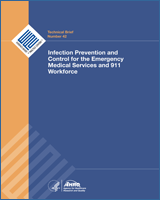NCBI Bookshelf. A service of the National Library of Medicine, National Institutes of Health.
Structured Abstract
Objectives:
To summarize current evidence on exposures to infectious pathogens in the emergency medical services (EMS) and 911 workforce, and on practices for preventing, recognizing, and controlling occupationally acquired infectious diseases and related exposures in that workforce.
Review methods:
We obtained advice on how to answer four Guiding Questions by recruiting a panel of external experts on EMS clinicians, State-level EMS leadership, and programs relevant to EMS personnel, and by engaging representatives of professional societies in infectious diseases and emergency medicine. We searched PubMed®, Embase®, CINAHL®, and SCOPUS from January 2006 to March 2022 for relevant studies. We also searched for reports from State and Federal Government agencies or nongovernmental organizations interested in infection prevention and control in the EMS and 911 workforce.
Results:
Twenty-five observational studies reported on the epidemiology of infections in the EMS and 911 workforce. They did not report demographic differences except for a higher risk of hepatitis C in older workers and severe acute respiratory syndrome coronavirus 2 (SARS-CoV-2) in minorities. EMS clinicians certified/licensed in Advanced Life Support have a high risk for blood and fluid exposure, and EMS clinicians had a higher risk of hospitalization or death from SARS-CoV-2 than firefighters whose roles were not primarily related to medical care. Eleven observational studies reported on infection prevention and control practices (IPC), providing some evidence that hand hygiene, standard precautions, mandatory vaccine policies, and on-site vaccine clinics are effective. Research on IPC in EMS and 911 workers has increased significantly since the SARS-CoV-2 pandemic.
Conclusions:
Moderate evidence exists on the epidemiology of infections and effectiveness of IPC practices in EMS and 911 workers, including hand hygiene, standard precautions, mandatory vaccine policies, and vaccine clinics. Most evidence is observational, with widely varying methods, outcomes, and reporting. More research is needed on personal protective equipment effectiveness and vaccine acceptance, and better guidance is needed for research methods in the EMS and 911 worker setting.
Contents
Suggested citation:
Jenkins JL, Hsu EB, Russell A, Zhang A, Wilson LM, Bass EB. Infection Prevention and Control for the Emergency Medical Services and 911 Workforce. Technical Brief No. 42. (Prepared by the Johns Hopkins University Evidence-based Practice Center under Contract No. 75Q80120D00003.) AHRQ Publication No. 22(23)-EHC039. Rockville, MD: Agency for Healthcare Research and Quality; November 2022. DOI: https://doi.org/10.23970/AHRQEPCTB42. Posted final reports are located on the Effective Health Care Program search page.
This report is based on research conducted by the Johns Hopkins University Evidence-based Practice Center (EPC) under contract to the Agency for Healthcare Research and Quality (AHRQ), Rockville, MD (Contract No. 75Q80120D00003). The findings and conclusions in this document are those of the authors, who are responsible for its contents; the findings and conclusions do not necessarily represent the views of AHRQ. Therefore, no statement in this report should be construed as an official position of AHRQ or of the U.S. Department of Health and Human Services.
None of the investigators have any affiliations or financial involvement that conflicts with the material presented in this report.
The information in this report is intended to help healthcare decision makers—patients and clinicians, health system leaders, and policymakers, among others—make well-informed decisions and thereby improve the quality of healthcare services. This report is not intended to be a substitute for the application of clinical judgment. Anyone who makes decisions concerning the provision of clinical care should consider this report in the same way as any medical reference and in conjunction with all other pertinent information, i.e., in the context of available resources and circumstances presented by individual patients.
This report is made available to the public under the terms of a licensing agreement between the author and the Agency for Healthcare Research and Quality. Most AHRQ documents are publicly available to use for noncommercial purposes (research, clinical or patient education, quality improvement projects) in the United States, and do not need specific permission to be reprinted and used unless they contain material that is copyrighted by others. Specific written permission is needed for commercial use (reprinting for sale, incorporation into software, incorporation into for-profit training courses) or for use outside of the U.S. If organizational policies require permission to adapt or use these materials, AHRQ will provide such permission in writing.
AHRQ or U.S. Department of Health and Human Services endorsement of any derivative products that may be developed from this report, such as clinical practice guidelines, other quality enhancement tools, or reimbursement or coverage policies, may not be stated or implied.
A representative from AHRQ served as a Contracting Officer’s Representative and reviewed the contract deliverables for adherence to contract requirements and quality. AHRQ did not directly participate in the literature search, determination of study eligibility criteria, data analysis, interpretation of data, or preparation or drafting of this report.
AHRQ appreciates appropriate acknowledgment and citation of its work. Suggested language for acknowledgment: This work was based on an evidence report, Infection Prevention and Control for the Emergency Medical Services/911 Workforce, by the Evidence-based Practice Center Program at the Agency for Healthcare Research and Quality (AHRQ).
